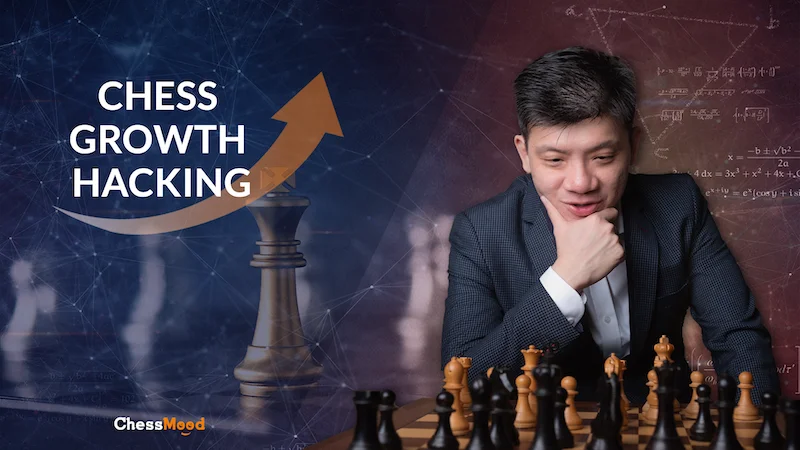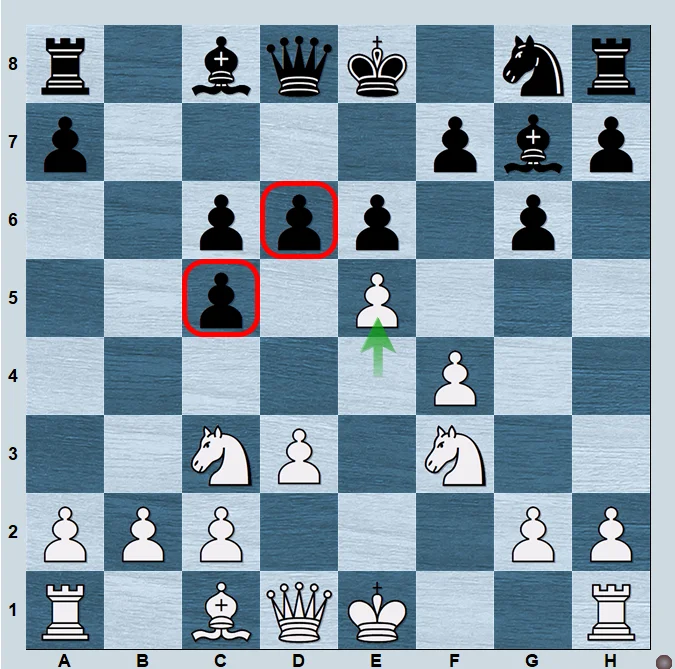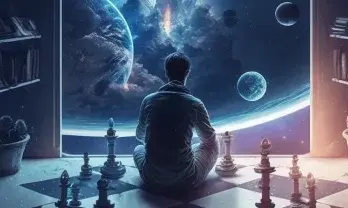How Kevin used ChessMood openings to help him finally become a Grandmaster
Discover how Kevin became a Grandmaster using ChessMood.
Discover how Kevin became a Grandmaster using ChessMood.

Every chess player reaches a point in their career when their rating either stops increasing or worse, starts going backward. For Singapore’s top-rated player, Kevin Goh, this was a familiar story. For more than a decade, he’d been stuck as an International Master. And with his rating stagnant, Kevin realized he needed to do something different if he was to finally fulfill his long-held ambition to become a Grandmaster.

In November 2011, Kevin had a classical FIDE rating of 2451, yet almost 6 years later in September 2017, Kevin’s rating had actually decreased by 7 points to 2444.
“I knew I had a problem. From 2012 onwards. I was playing some decent chess and I was getting really close but I wasn’t really closing out games. For instance, in the 2014 Olympiad, I just needed a draw in round 10 and I couldn’t do it – and that was an important GM norm game for me. There were many events that I played decently but the problem with me was that I wasn’t consistent enough.”
“It just felt like I was almost there but not quite. If you’re truly playing at a Grandmaster level, you really shouldn’t struggle that much. Basically, I was choking far too often. So I thought I needed a new perspective. That’s why I started looking out for other resources on top of the coaching that I was already doing with GM Boris Avrukh.”
Then, in April 2019, Kevin’s quest took on new urgency when he learned the sad news that his father had been diagnosed with pancreatic cancer.
“When my father was diagnosed, I thought it would be nice if he could see me become a Grandmaster. And while I ultimately play chess for myself, there became a time urgency in the sense that I wanted to at least see if I could make it before he leaves. He likes to see me on the news, and it really drove my desperation level a little bit higher.”
As if by magic, shortly afterwards when Kevin was scrolling through his Facebook feed, he was targeted by an intriguing ad.
“Being a chess lover, I see quite a few targeted ads on Facebook, but one-day ChessMood popped up on my feed. I didn’t know of ChessMood or Grandmaster Avetik Grigoryan at all beforehand but I decided to click it anyway.”
Despite liking the look of what he saw, Kevin remained suspicious.
“As a professional accountant, I have a high level of skepticism in everything I see on the internet and I tend to assume most people are over-selling. So my initial thought was this could be just another salesman – even though he’s obviously a strong Grandmaster. But there are many strong players out there selling their stuff and it’s hard to know which of them actually produce good content and learning material.”
With this in mind, Kevin cautiously messaged GM Grigoryan to probe a bit deeper.
“We exchanged a few words on Facebook and I asked him if ChessMood is ideal for players who want to become a Grandmaster. He told me the openings could form a good basis but that the video courses mainly cater to players who are rated up to 2,400. However, accompanied with some private lessons, we could explore the lines even deeper to a Grandmaster level.”
“In the end, what finally convinced me to join was when he said he will only take me on as a student if I’m a serious guy. So if I’m not fully committed to becoming a Grandmaster then he said he’ll just stop. He made it very clear from the first couple of exchanges we had that he was not just doing this for the money. He wants to feel engaged and to be a part of what we’re going to build together. So I think more or less, that convinced me to try this out.”
Encouraged by his chat, Kevin began to study the lines and openings advocated on ChessMood.
“Avetik told me to sign up on ChessMood and start watching the videos that were already there, then afterwards we could go more in-depth – rather than us starting from scratch which would take a lot of time. So I watched all the videos. All the Scotch videos. All the Grand Prix attacks. And all the rest. And it didn't take me very long to see that these lines would be ideal as a surprise weapon for the events that I was planning to play in December 2019. So we decided to build a new repertoire for this purpose.”
While many players feel uncomfortable by the idea of learning new repertoires that they’re unfamiliar with, Kevin decided to fully embrace the idea – and started seeing some early results from it.
“I’m quite happy to change my repertoire at any time of the day, any day of the week. For example, previously I always had problems with the Petroff, particularly with the exchange variation, but I found the ChessMood lines with 5.Nc3 to be extremely effective. And I really started to like the Grand Prix attack against d6. I tested it out many times on the internet and would get great positions even against very strong players.”

ChessMood Grand Prix Attack ChessMood Petroff with 5.Nc3
To fulfil his inner-scepticism and make sure that the lines advocated on ChessMood were trustworthy and suitable for such a high level, Kevin started checking them after his classes.
“When you look at the explanations, you look at the lines and you see how deep the lines go, you quickly get a sense of whether they’re solid. Be it for books or any other chess material, I always analyse lines myself and don’t take anything at face value. Sometimes I run them through engines or look at some recent games. And I found the ChessMood lines and even the novelties make a lot of sense.”
Watching the courses and learning new openings is only the first step. But to be able to play them in tournaments, you need to memorize them, something which most high-level players find challenging. For Kevin, this was particularly tricky as in addition to his ambition to become a Grandmaster, he is also the CFO of Lucence, one of the most promising biotechnology start-ups in Singapore.
“Scrolling through moves on ChessBase is definitely something that everybody does. You do a scroll and then you pretend you’re trying to memorize it – but the problem is the next day you forget everything.”
With this in mind, GM Grigoryan advocated that he switch to a more active way of learning, by applying the ChessMood openings through blitz games using the golden method.
“Blitz definitely helps a lot, I can’t overemphasize this. It’s important not to take the games too seriously though. You may lose a few games here and there but I think it’s important you use them to help with your understanding. This is what I learned from using the ChessMood method of playing 9 games.”
“For example, in the Grand Prix Attack, in the Grischuk line with d4, after cxd4, nb5 and 0-0, you need to play Bb3 which is a really difficult line to remember as your natural instinct is to make the mistake of recapturing the pawn on d4.

But if something like this happens to you twice online, you probably won’t make the same mistake again unless you don’t review your games.”
Not only did Kevin try to shift his learning to more active methods, but he also began to work in line with his energy level.
“I spend a lot of time working on openings during the weekdays and the reason is that I want to work on my calculation over the weekends when my mind is a lot fresher. If you try to solve puzzles after a long day at work, it’s just not fun. You can try and if you succeed and if you have the energy to do so, I think it’s great. But if you don’t have that kind of energy level and you’re tired, most likely you won’t have a good outcome and that becomes discouraging.”
In addition, while Kevin struggled to regularly tune in to the ChessMood webinars and events due to his timezone and commitments, he saw great value in the lessons, even while fighting to become a Grandmaster.
“I remember there was one random stream where I was busy so I only saw the first 10 minutes, but even that taught me new ideas. Avetik was explaining about the pawn structure in the Grand Prix when after 1.e4 c5 2.Nc3 Nc6 3.Bb5 d6, he was saying this is a bad move because of 4.Bc6 bxc6 and then 5.d3.

Then you just wait for black to play e6, white goes f4, nf3 and if black goes e6, you go e5 and break the pawn structure.

That was one thing that I remember very clearly and subsequently used in my blitz games to great effect.”
With a FIDE rating of 2465 in May 2019, Kevin needed 35 more ELO points to officially become a Grandmaster, having already secured the necessary GM norms. But Kevin noticed that the pressure when playing for every point was far greater than before.
“During the games, my stress level was exceptionally high because every game is high stakes. Especially for me who’s playing for ratings, not really for norms. Every single game, rating games, I could lose rating points most of the time. So if you play against someone low-rated, you have that pressure to win the game. You cannot just say ‘okay, I’ll take the draw with black and let me relax on my next game.’ Which is what you can do when you play for GM norms but you can’t do that when you’re playing for a rating.”
It wasn’t just the stress of chasing points, but also the stress of putting everything on the line to fight for victory.
“On the flight, on the way to the event, you always think I spent all this money, this bloody air ticket, all this hotel cost, and then you’re paying for food, entry fees, and then you’re taking time away from work. The time that you can use to be better at your job possibly. You don’t want to come back with nothing. But then nobody owes you a living, right? In my case, I could lose rating points. I can lose time and money and come back with nothing. Definitely that sort of pressure was not that easy. I would recommend bringing along a good friend of yours to have someone to talk to when things go badly and if something goes well, then you can celebrate together. Have a good meal. Have a good laugh. I would definitely recommend that.”
After playing some events in Serbia, Kevin played a tense match-up against Vietnamese Grandmaster Nguyễn Anh Dũng.
“I played a couple of Scotches in my white games, which came from ChessMood preparation, but the final score was 2-2 and I narrowly missed the required rating points.”

In fact, by January 2020, Kevin was rated 2,499, just 1 point away from hitting the elusive 2,500 level and being crowned a Grandmaster.
“Then I went to Myanmar to play against the #1 Myanmese player IM Wynn Zaw Htun and it was an 18 game marathon event with classical, rapid, and blitz games. In the standard events I played 2 Scotch games which I won both, and also in the rapid and blitz, I played many ChessMood openings.
Due to ChessMood, I play a lot of Scotches. I have 18 games with White since I’ve trained with GM Grigoryan. In total, I’ve had 12 wins and 6 draws, including 5 wins and 1 draw with the Scotch.”

Above: Kevin takes on the Reti opening against IM Wynn Zaw Htun with Gabuzyan’s 1…c5 course.
After his victories in the classical chess portion, on March 3rd, 2020 at the age of 36, Kevin obtained a FIDE rating of 2,501, finally achieving the title of Grandmaster.
“At the end of everything, I didn’t derive any joy, just pure relief that I finally got there!”
When asked what the future holds for him and chess, Kevin was very humble in his response.
“I’m 2,501 which probably means that I’m not really a 2,500 player. Just because you crossed the line doesn’t mean that you are that level. I’ve seen many players who hit 2,400 and they went back down, never to come back up again. I would like to remain at that level, though whether I can improve and go beyond that is something to be seen. I would like to keep my rating around 2,500, 2,510 and then we can see if it has the potential to level up to 2,550.”
And in his closing remarks, Kevin stressed that now that he's achieved his main goal, he can focus more on giving back to the chess community.
“I would like to start working with young players, young talents, to sort of correct the errors that I’ve never managed to address. I do have one very young student and we are working on endgames now because he’s a young player. I enjoy working with young talents who are enthusiastic about the game. It’s a joy to work with these players.”
Thanks for reading! Do you feel inspired to improve your own chess? Feel free to share any questions or thoughts in our forum.
Originally published Feb 15, 2022

